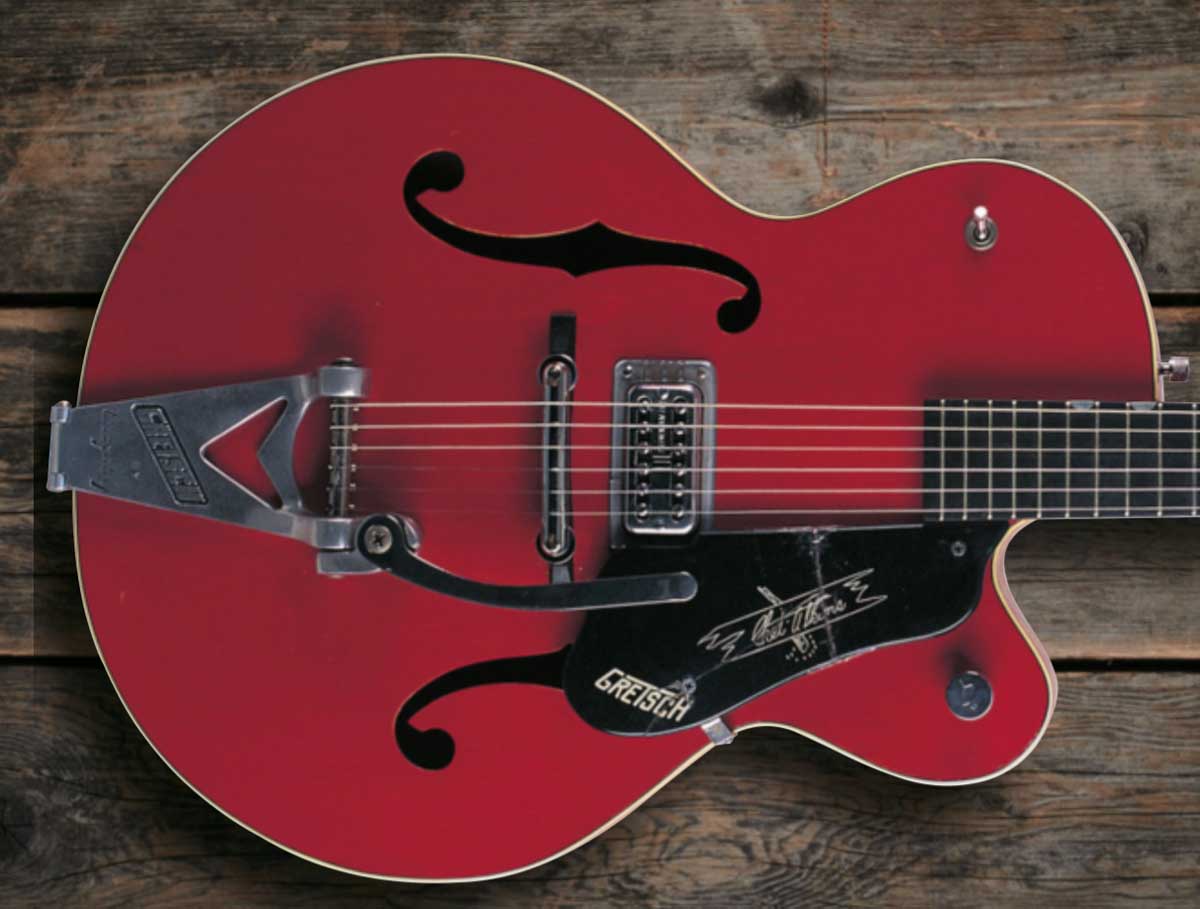Gretsch Chet Atkins signature models: everything you need to know
Chet Atkins will always be remembered for his golden-era Gretsch guitars, but can you remember which one’s which?

Chet Atkins (1924-2001) is probably the most important guitarist ever to be associated with the Gretsch guitar brand. His original line of signature models, which were launched in the 1950s, were seen in the hands of some of the most influential guitarists known to rock ’n’ roll.
Eddie Cochran, Duane Eddy and George Harrison were all famous exponents of Gretsch Chet Atkins signature models in the early days, and in later years these guitars continued to be the go-to instruments for countless professional players across a broad range of styles from country, blues and rockabilly right through to hard-rock and punk.
A master of the electric guitar, gifted engineer and producer, popular recording artist and radio/TV star – Chet Atkins was as important to Gretsch as Les Paul was to Gibson.
It happened to be Jimmie Webster – Gretsch’s innovative guitar demonstrator and promoter – who first approached Chet in 1954 about collaborating on a signature model.
As a D’Angelico archtop player and compulsive tinkerer of audio electronics, Chet certainly knew his way around a good guitar and his standards were high. From the off, he had a hand in developing the instruments that bore his name, ultimately leading to some of the most timeless designs known to the guitar world.
6120 Chet Atkins Hollow Body/Nashville

Chet Atkins’ involvement with Gretsch began in 1954 with the 6120 Hollow Body. Although he would have significant influence on the design by requesting the addition of a metal bridge, metal nut and Bigsby tailpiece, the bulk of it was already in place by the time Chet arrived, courtesy of Jimmie Webster.
Derived from the Gretsch Streamliner 16-inch electric archtop, the prototype was labelled ‘Streamliner Special’ and featured Gretsch Round Up-style western motifs and an ‘Amber Red’ orange finish.
All the latest guitar news, interviews, lessons, reviews, deals and more, direct to your inbox!
Chet rarely played the 6120, instead preferring his 6122 Country Gentleman – a guitar that he had significantly more involvement in the design of from the beginning
Although he was photographed with it, Chet rarely played the 6120, instead preferring his 6122 Country Gentleman – a guitar that he had significantly more involvement in the design of from the beginning.
In 1964, the 6120’s name changed from Hollow Body to Nashville in reference to Chet’s musical legacy as manager and producer at RCA Studio B – recording home of the ‘Nashville sound’ and hitmakers such as Elvis Presley, The Everly Brothers and Dolly Parton.
6121 Chet Atkins Solid Body

Following the release of the Gibson Les Paul Model in 1952, Gretsch entered the solidbody market in 1953 with the single-cutaway Duo Jet. The following year, the company released two similar (chambered) solidbody models: the sparkle-finish Silver Jet and western-themed orange-finish Round Up – the latter being virtually identical to the Bigsby-equipped, maple-topped 6121 Chet Atkins Solid Body.
Discontinued by 1963, this guitar is the rarest of these four Chet Atkins signature models. Despite his status as a leading country guitarist, Chet was not a fan of the western-themed motifs of the 6120 and 6121 models and these appointments were toned down within a few years of the instruments’ 1955 Gretsch catalogue debut.
Although both guitars retained their orange ‘Amber Red’ finish, the steer head peghead inlay and steers and cacti-engraved fretboard markers were changed to a horseshoe emblem and subtler block inlays during ’56, while the G-branded top logo disappeared in ’57.
6122 Chet Atkins Country Gentleman

Released in 1957, the 6122 Country Gentleman electric hollowbody measures 17 inches across (a full inch wider than the 6120) and at around two inches deep was Gretsch’s first thinline archtop.
The 6122, 6120 and 6121 all began life as single-cutaway instruments but switched to a double-cutaway design during 1961, at which time the 6120 and 6119’s large open f-holes were replaced by 6122-style simulated f-holes.
Chet was dissatisfied with the sound of the DeArmond Model 2000 (‘Gretsch-Dynasonic’) pickups as seen on his 6120 Hollow Body and 6121 Solid Body signature models, finding the neck pickup to be too bassy and the bridge pickup overly bright.
Having worked with electronics engineer Ray Butts in the development of the Filter’Tron pickup, it was soon settled the 6122 would feature the new humbucker. The results were impressive enough that Gretsch decided the 6119, 6120 and 6121 would follow suit in 1958.
6119 Chet Atkins Tennessean

Featuring a single Filter’Tron humbucking pickup adjacent to the bridge, the 16-inch wide 6119 Tennessean hollowbody archtop was launched in 1958 and was considered a less fancy alternative to the 6120.
Chet Atkins was photographed with a 6119 on the cover of his 1960 album Workshop and was known to favour the Tennessean as a working instrument, as did George Harrison who recorded and gigged with it during 1964 and 1965.
Unlike the other three Chet Atkins signature models featured here, the Tennessean did not change to a double-cutaway design during ’61, although it did receive imitation f-holes in line with the other hollowbody archtops. At the same time, its single Filter’Tron humbucker was supplanted by dual HiLo’Tron single coils.
The 6119 can also be distinguished by its ‘Dark Cherry Red’ and/or 6122-style walnut-coloured ‘mahogany grain’ finish, as opposed to the bright ‘Amber Red’ orange of the 6120 and 6121.
Rod Brakes is a music journalist with an expertise in guitars. Having spent many years at the coalface as a guitar dealer and tech, Rod's more recent work as a writer covering artists, industry pros and gear includes contributions for leading publications and websites such as Guitarist, Total Guitar, Guitar World, Guitar Player and MusicRadar in addition to specialist music books, blogs and social media. He is also a lifelong musician.

